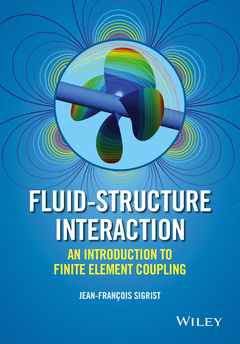Fluid-Structure Interaction An Introduction to Finite Element Coupling
Auteur : Sigrist Jean-François

Fluid-Structure Interaction: An Introduction to Finite Element Coupling fulfils the need for an introductive approach to the general concepts of Finite and Boundary Element Methods for FSI, from the mathematical formulation to the physical interpretation of numerical simulations. Based on the author?s experience in developing numerical codes for industrial applications in shipbuilding and in teaching FSI to both practicing engineers and within academia, it provides a comprehensive and self?contained guide that is geared toward both students and practitioners of mechanical engineering. Composed of six chapters,
Fluid?Structure Interaction: An Introduction to Finite Element Coupling progresses logically from formulations and applications involving structure and fluid dynamics, fluid and structure interactions and opens to reduced order-modelling for vibro-acoustic coupling. The author describes simple yet fundamental illustrative examples in detail, using analytical and/or semi?analytical formulation & designed both to illustrate each numerical method and also to highlight a physical aspect of FSI. All proposed examples are simple enough to be computed by the reader using standard computational tools such as MATLAB, making the book a unique tool for self?learning and understanding the basics of the techniques for FSI, or can serve as verification and validation test cases of industrial FEM/BEM codes rendering the book valuable for code verification and validation purposes.
Foreword ix
Images Credits xi
Preface xiii
1 Fluid–Structure Interaction 1
1.1 A Wide Variety of Problems 2
1.2 Analytical Modelling of Fluid–Structure Interactions 3
1.2.1 Potential Flow. Inertial Coupling 4
1.2.2 Viscous Flow. Viscous Damping 7
1.2.3 Compressible Flow. Radiation Damping 10
1.3 Numerical Simulation of Fluid–Structure Interactions 13
1.4 Finite Element and Boundary Element Methods 20
2 Structure Finite Elements 25
2.1 Vibrations of an Elastic Structure 26
2.1.1 Modelling Assumptions 26
2.1.2 Equations of Motion 33
2.2 Finite Element Method: Practical Implementation 35
2.2.1 Weighted Integral Formulation 35
2.2.2 Finite Elements 37
2.2.3 Elementary Matrices 38
2.2.4 Mass and Stiffness Matrices 40
2.2.5 Calculating and Assembling Matrices 45
2.2.6 Modal Analysis 50
2.3 Example: Bending Modes 52
2.3.1 Bending Motion of a Straight Elastic Beam 52
2.3.2 Bernoulli Beam Elements: 1D Element 54
2.3.3 Bending Modes 57
2.4 Example: Coupled Bending/Membrane Modes 61
2.4.1 Bending and Membrane Motion of a Circular Elastic Ring 61
2.4.2 Fourier Component Representation: 0D Element 62
2.4.3 Bending/Membrane Modes 64
3 Fluid Finite Elements 75
3.1 Fluid Flow Equations 76
3.2 Compressibility Waves 84
3.2.1 Wave Equation 84
3.2.2 Boundary Conditions 88
3.3 Finite Element Method 96
3.3.1 Pressure-Based Formulation 96
3.3.2 Displacement-Based Formulations 100
3.3.3 Finite Element Matrices 103
3.4 Boundary Element Method 105
3.4.1 Green Function and Green’s Integral Theorem 105
3.4.2 Interior and Exterior Problems 106
3.4.3 Direct and Indirect Boundary Element Method 108
3.4.4 Boundary Element Matrices 111
3.5 Example: Sloshing Modes 113
3.5.1 Circular Reservoir with Fluid-Free Surface 113
3.5.2 2D Axisymmetric Elements with Gravity 115
3.5.3 Sloshing Modes 117
3.6 Example: Acoustic Modes in an Open Reservoir 119
3.6.1 Cylindrical Acoustic Opened Cavity 119
3.6.2 2D Axisymmetric Elements with Compressibility 120
3.6.3 Acoustic Modes 121
3.7 Example: Acoustic Modes in a Closed Reservoir 122
3.7.1 Rectangular Acoustic Closed Cavity 122
3.7.2 2D Fluid Elements with Compressibility 124
3.7.3 Acoustic Modes 125
3.8 Example: Acoustic Radiation in Infinite Fluid 125
3.8.1 Pulsating Ring in Infinite Acoustic Fluid 125
3.8.2 1D Axisymmetric Element with Radiation Condition 127
3.8.3 1D Boundary Elements 128
3.8.4 Acoustic Radiation 131
4 Inertial Coupling 137
4.1 Mathematical Modelling 138
4.2 Added Mass Matrix 140
4.2.1 Coupling Matrix 140
4.2.2 Added Mass Matrix 142
4.2.3 Inertial Effect 143
4.3 Modelling Inertial Coupling for Complex Systems: Example of Tube Bundle 150
4.3.1 Analytical Models for Added Mass 150
4.3.2 ‘Term-to-Term’ Computation of the Added Mass Matrix 150
4.3.3 A Homogenisation Technique 154
4.4 Examples: Inertial Effect in Bounded Domain 164
4.4.1 Analytical Calculation of the Added Mass Matrix 164
4.4.2 Numerical Computation of the Added Mass Matrix 169
4.5 Example: Inertial Effect in Unbounded Domain 175
4.5.1 Elastic Ring Immersed in a Fluid 175
4.5.2 Finite Element Coupling with Infinite Element 177
5 Fluid–Structure Coupling 185
5.1 Modelling Assumption 186
5.2 Interior Problems: Vibro-Acoustic and Hydro-Elastic Coupling 186
5.2.1 Non-Symmetric Formulation 186
5.2.2 Symmetric Formulation 190
5.3 Exterior Problem: Vibro-Acoustic 199
5.4 Example: Vibro-Acoustic Coupling and Hydro-Elastic Sloshing 205
5.5 Example: Acoustic Damping 212
5.5.1 Analytical Modelling 212
5.5.2 Numerical Computation 215
6 Structural Dynamics with Fluid–Structure Interaction 225
6.1 Introduction 226
6.2 Time-Domain Analysis 228
6.2.1 Direct Methods 228
6.2.2 Modal Methods 237
6.3 Frequency-Domain Analysis 248
6.3.1 Direct and Modal Methods 248
6.3.2 Computation of the Projection Basis 250
6.4 Example: Time-Domain Analysis 254
6.4.1 Accelerated Cantilever Beam with Fluid Coupling 254
6.4.2 System and Excitation Spectra 258
6.4.3 Seismic Response: Direct and Modal Methods 259
6.5 Example: Frequency-Domain Analysis 264
6.5.1 Acoustic Radiation of a Damped Structure Immersed in a Fluid 264
6.5.2 Frequency Response: Direct and Modal Methods 266
Index 281
Jean-François SIGRIST, DCNS Research, France.
Date de parution : 10-2015
Ouvrage de 304 p.
17.5x25.2 cm
Thème de Fluid-Structure Interaction :
Mots-clés :
Finite Element Coupling; concepts; Finite Element Methods; FEM; Boundary Element Methods; FSI; mathematical; formulation; numerical; simulations; numerical codes; applications; shipbuilding; engineers; academia; comprehensive; self-contained; guide; students; practitioners; mechanical engineering; structure; fluid dynamics; fluid; interactions; reduced order-modelling; vibro-acoustic coupling; examples; analytical; formulation; numerical method; computational; tools; MATLAB; basics techniques; verification; validation; test cases; BEM; mechanical engineering; engineering



